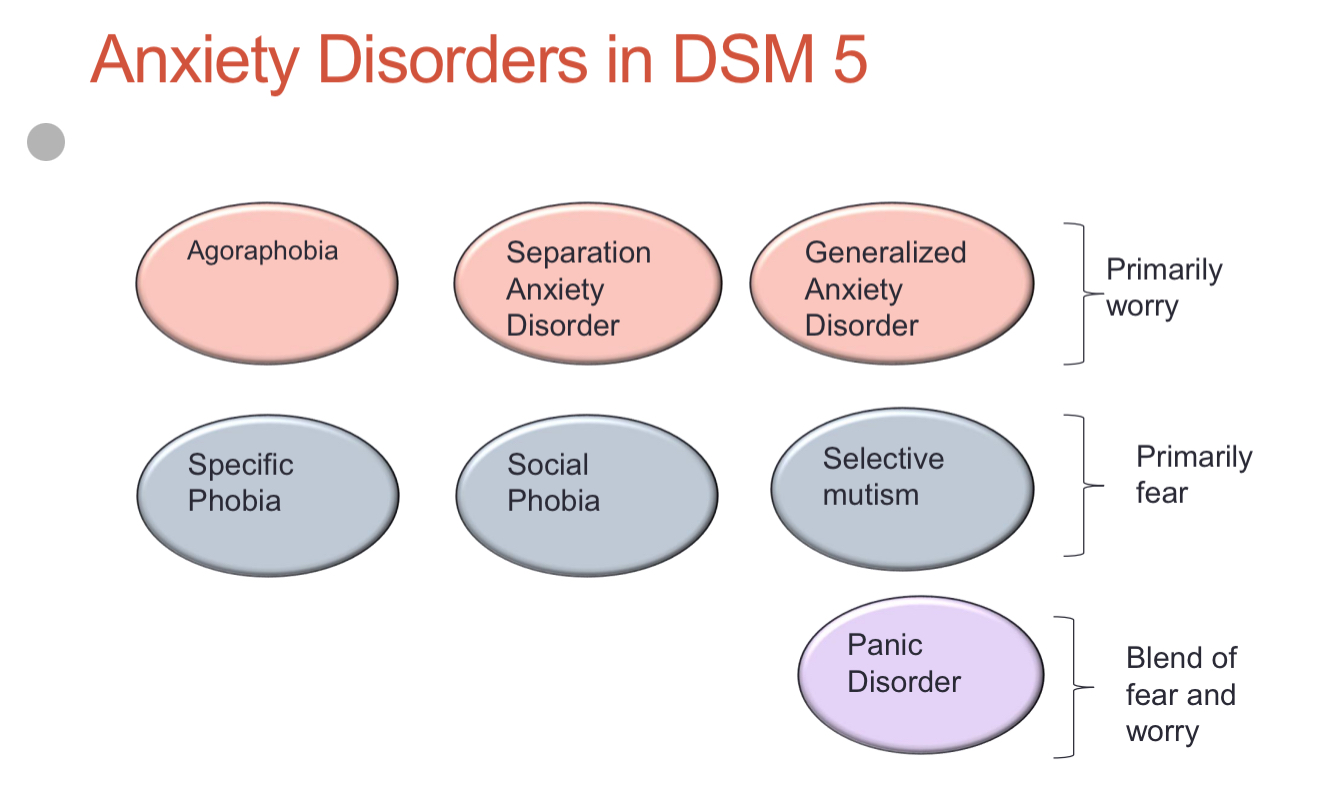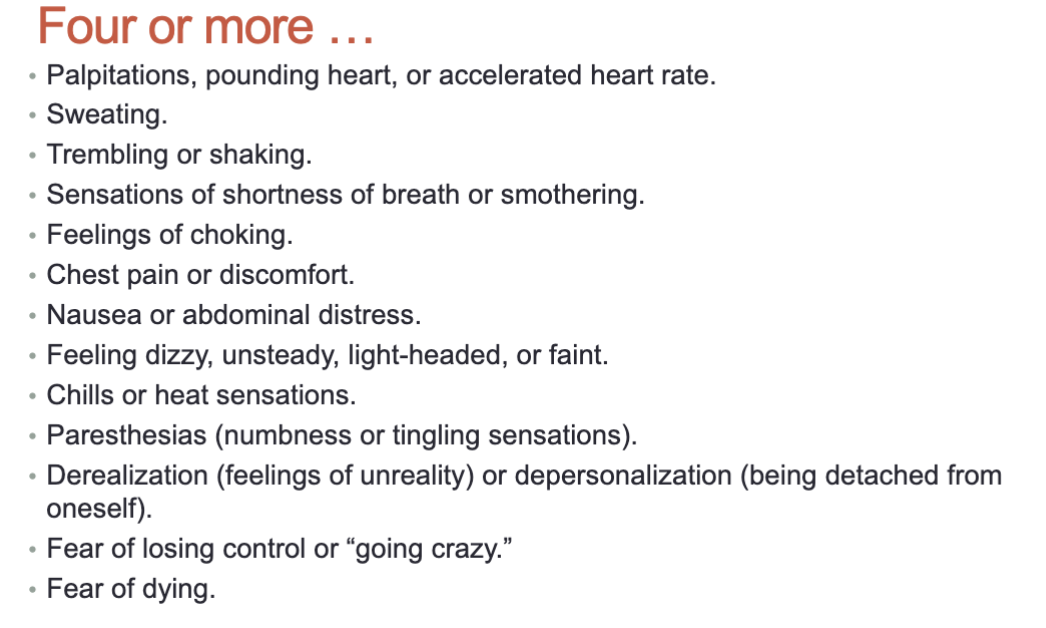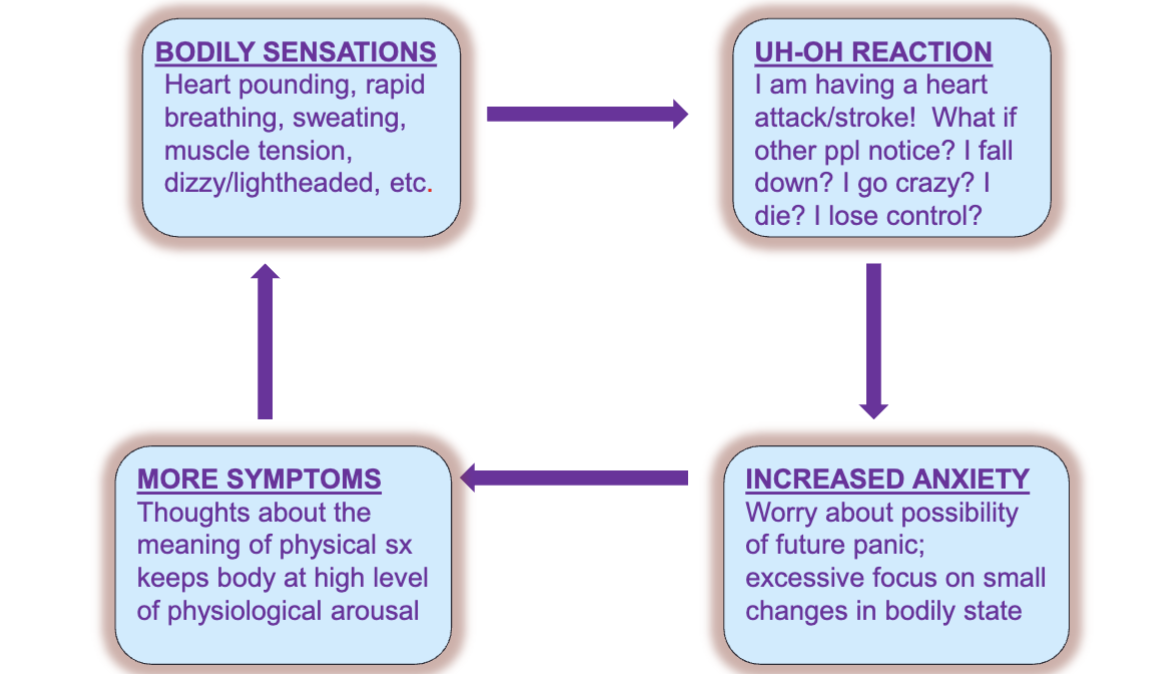HD 3700 Prelim 2- Anxiety disorders
1/43
There's no tags or description
Looks like no tags are added yet.
Name | Mastery | Learn | Test | Matching | Spaced |
|---|
No study sessions yet.
44 Terms
Anxiety
emotional state marked by anticipation of danger/misfortune, intense distress, bodily tension, and nervousness
Where does anxiety stem from?
response to perceived threat
vital role in survival
high prevalence stems form ancestors that had the keenest reactions to threat
creates physical change (fight/flight)
Anxiety Disorders
levels of enxuety that are frequent, debilitating and disproportionate to the circumstances
among the most prevalent psychological disorders
1/3 will experience
commonly start in childhood
More criteria:
fear or anxiety is out of proportion
persistent
clinically significant distress or impairment in social, occupational, or other important areas of functioning
failure to meet this last criteria is why most of our normal fears are not considered phobias
Physical Signs of anxiety
derived from fight/flight
prioritize directing energy to most essential functions for survival
same symptoms regardless of the circumstances that bring them on —reflecting the fight/flight is effective against many types of threat
some physical reactions
rapid heart rate
shortness of breath
sweating
slowed digestion
dilated pupils
redistribution of blood flow
muscle tension
2 main cognitive symptoms
perception of threat or danger
`when we are anxious, we perceive ourselves as in danger, even though we are physically safe
worry: repetitive negative thoughts about the possibility of the future danger, misfortune, or hardship
both often illusionary
How is fear and worry different?
related, but fear tends to present-oriented, worry is future-oriented
Anxiety disorders in DSM 5

comorbidity
anxiety disorders are highly comorbid with each other
people may often have predisposition towards anxiety, but will have different anxiety disorders at different points in their lives
Specific Phobia
marked fear and anxiety about a specific object or situation
phobic object or situation almost always provokes immediate fear or anxiety
the phobic object or situation is actively avoided or endured with intense fear or anxiety
Main Phobia Categories
blood, injection, injury
situations (enclosed spaces, airplanes)
natural environment (storms, heights)
animals
Avoidance
the main behavioral symptoms of anxiety
is a paradox:
reduces anxiety short-term
increases anxiety long-term
solidifies beliefs around phobic stimulus
limits opportunity to learn that seemingly threatening circumstances are not dangerous
provides negative reinforcement
Treating Phobias
eliminate reinforcement associated with avoidance
if we consciously modify an avoidant behavior, we can change the beliefs that maintain anxiety and anxious feelings themselves
Exposures (CBT)
exposure to fear-provoking stimulus, but limiting the anxiety-reducing response
habituate occurs: body acclimates to the feeling of anxiety
forms new beliefs about the feared situation and their ability to cope with it
without avoidance, anxiety WILL be experienced
Fear and Avoidance Hiearchy
developed collaboratively with therapist
ordered list of situations in which a client experiences fear of phobic stimulus
this is used as a guide for exposures in therapy; clients work from least feared to most feared stimulus
each situation is rated in terms of how much feared it generates and the lengths to which a client will go to avoid that situation
every hierarchy is individualized to client’s specific fears
Steps of Effective Exposures
identity thoughts about situation before exposure occurs
rate level of distress before exposure
during exposure..
continue to rate distress every 5 minutes
do not try to distract self
maintain objective awareness of physical symptoms and thoughts
continue exposure until anxiety goes down- 3or 4 on a scale of 10 is optimal
after exposure, rate level of distress and evaluate thoughts again
What’s the most important rule of anxiety treatment?
NEVER stop an exposure before habituation occurs
What can exposures be?
in session
in vivo (or in life)
imaginal
What is the goal of the anxiety?
to decrease the uncomfortableness
Social Anxiety disorder/ social phobia
fear or anxiety about one or more social situations in which the individual is exposed to possible scrutiny by others
Diagnostic criteria:
way person will act or show symptoms will be negatively evaluated
almost always provoke fear or anxiety
avoided or endured with intense fear or anxiety
fear or anxiety is out of proportion
last >6 months
Is social anxiety disorder Shyness?
shy people don’t show avoidant behaviors, fear of negatice evaluation, physical symptoms of anxiety in social situations, or impairment
12% consider themselves shy and 10% of thise described as shy by thier family members meet criteria for
What is the correlation between social anxiety and age?
foten in adolescence
prevalence: 9-13% and in more in females
twice in ages 18-29
less in collectivist cultures
more in individualistic cultures
Taijin Kyofusho
form of social anxiety present in japan but not in america, centered on concerns of embarrassing other vs. embarrassing oneself
Treatment for Social Anxiety?
CBT
fear and avoidance hierarchy
exposure to anxiety provoking social situations or events and re-evaluation of cognitions around these situations
group and individual treatments are equally effective
What is accompanied by panic attacks?
phobias and social anxiety disorder
What’s a panic attack?
abrupt surge of intense fear/discomfort that reaches a peak within minutes, and during which time four or more of the symptoms occur:
are time-limited, reach peak in about 10 minutes then decline

What does Social anxiety feel like?
“trouble catching breath”
“brain was trying to climb out of my head”
“it was like my body was trying to say to me- you’re about to die”
What are the 2 types of Panic Attacks?
situationally bound: clear triggers, part of experience of specific and social phobia for some people
snakes, bugs, flying, social situations
can be reduced by treating phobic stimuli that precede them
Not situationally bound: out of the blue
can even occur at night (panic disorder)
What is the frequency of panic attacks? (non situational)
varies widely
some daily, some multiple a day
can go weeks/ months without attack, but worry about having one and sho lots of avoidant behavior
Panic Disorder
recurrent panic attacks
at least 2 one of the attacks has been followed by >1 months:
persistent concern or worry about additional panic attacks or their consequences
significant maladaptive change in behavior related to the attacks
Agoraphobia
another DSM5-TR anxiety disorder
anxiety about being in places or situations from which escape might be difficult or in which hep may not be available in the event of having an unexpected or situationally predisposed panic attack or panic-like symptoms
panic attacks may occur with or without comorbid agoraphobia
examples of avoidance
restriction of caffeine
doing certain activities which safety mechanisms are there
catastrophic misinterpretations of physical sensations
associated with panic are believed to be the biggest reason some people develop panic disorder and other do not
Fear or Fear Model

Treatments for Panic Disorder
blend exposures with cognitive restructuring re panic
pyschoeducation
Why doe we make people more anxious in order to make them less anxious?
symptoms are exacerbated and maintained by avoidant behavior
exposures are a technique to extinguish the reinforcement associated with avoidance
with panic, people are trying to avoid the physical sensations of panic
Stage 1: Interoceptive exposures
designed to mimic the physical sensations of panic in a controlled, intentional way
fear and avoidance hierarchy is constructed from these symptoms
examples)
breath through straw
head rolling
running in space
interoceptive
perception of physical states
Stage 2: In Vivo exposures
therapist and client construct and follow fear and avoidance hierarchy for situations which typically bring on panic outside of therapy sessions
generalized anxiety disorder
excessive anxiety and worry occurring more days than not for at least 6 months
difficult to control the worry
restlessness
easily fatigued
difficulty concentrating or mind going blank
irritability muscle tension
sleep disturbance
anxiety, worry, or physical symptoms cause clinically significant stress or impairment in important areas of functioning
disturbance not attributable to other medical conditions of physiological effects of a substance
not better explained by another mental disorder
How is GAD different from other anxiety disorders?
GAD: worry about everyday events
focus of worries shifts frequently
meta worry
fewer “fight/flight’ symptoms: ore muscle tension
30-31 yrs old
less likely to present for treatment
more common in females
highly comorbid (MDD and other anxiety disorders)
chronic
more common is higher income countries
meta worry
worry about not being able to control worry
Newman’s contrast avoidance model
suggest people with GAD are extremely sensitive to shifts in emotional state
worrying keeps people in one state and prevents sharp increases in negative emotions
reframes worry from a passive thought process but to a logical adaptive coping response
Treatments of GAD
SSRIs, SNRIs
SBT or third adaptations to CBT
equally effective in short term